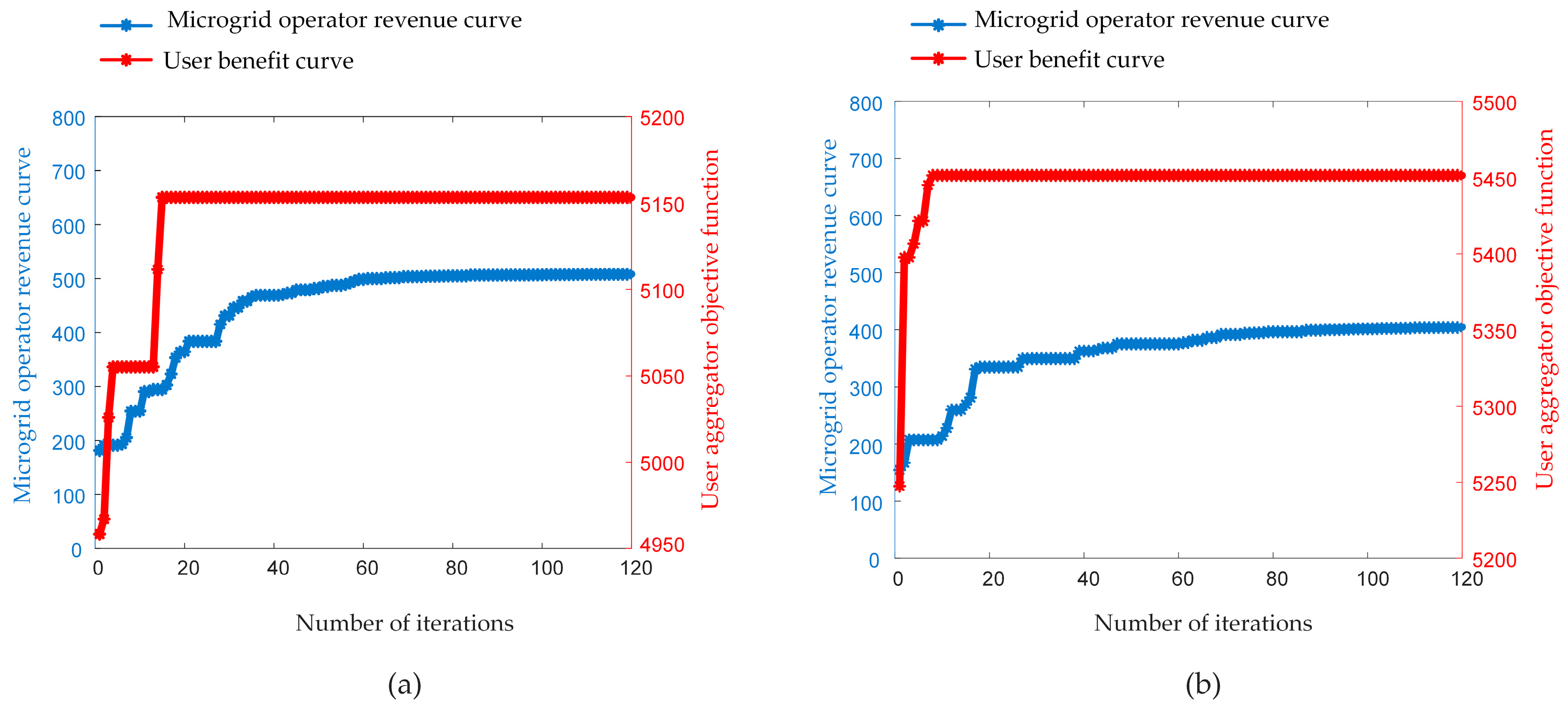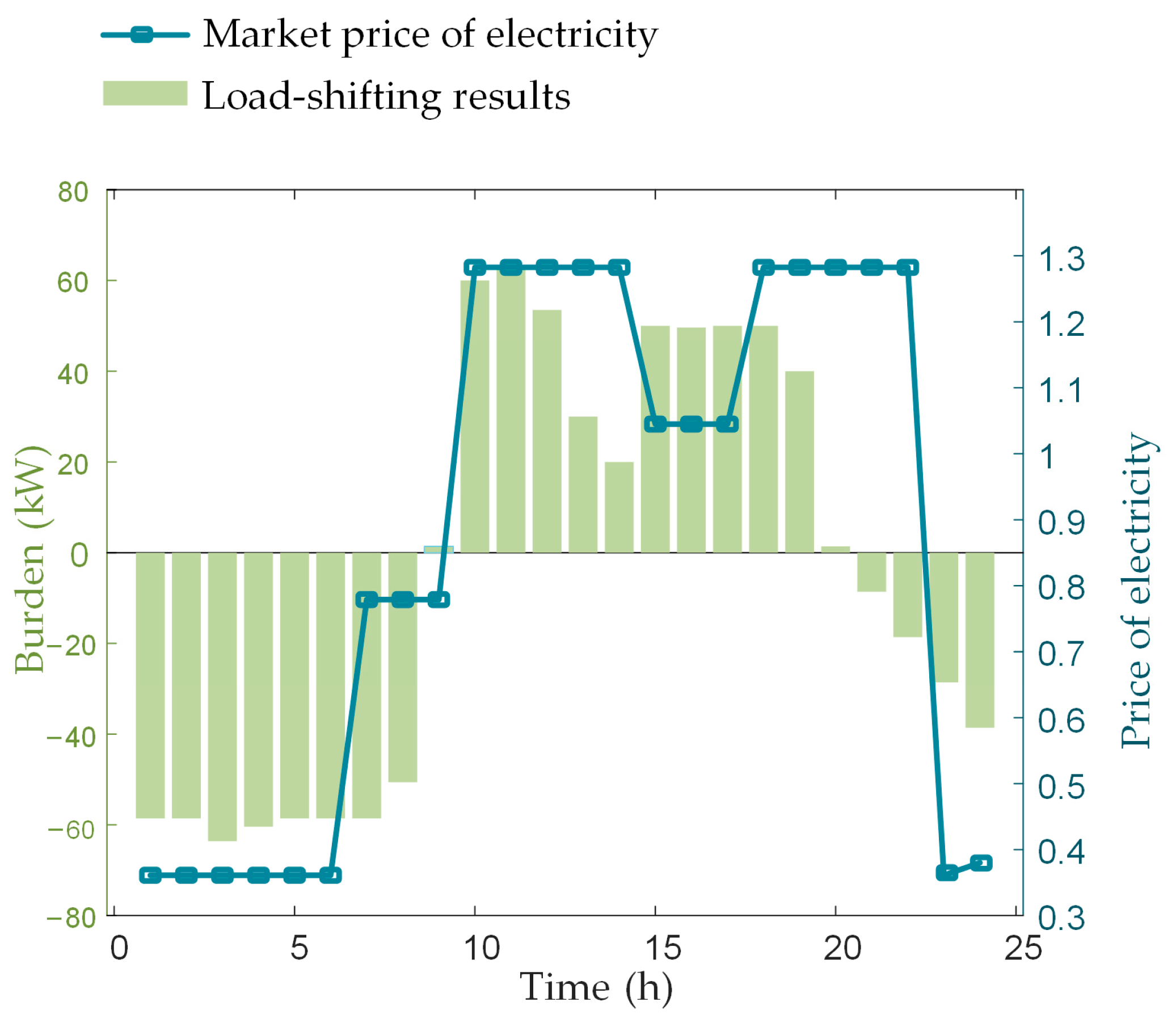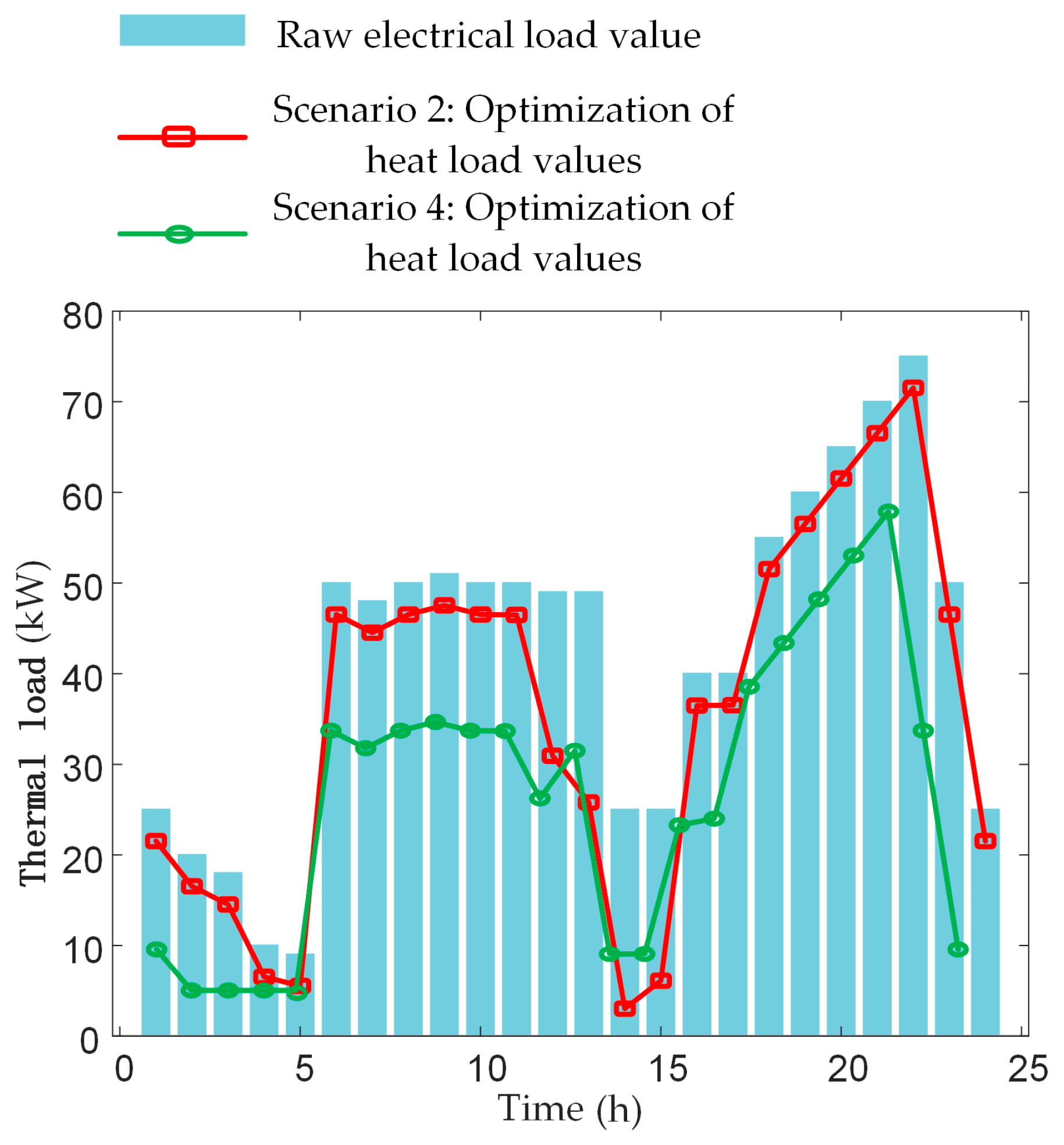Optimization Strategy for Integrated Energy Microgrids Based on Shared Energy Storage and Stackelberg Game Theory
Abstract
1. Introduction
2. Modeling of Integrated Energy Microgrid Systems
2.1. Electric Energy Interaction Model
2.1.1. Upper-Level Model
2.1.2. Lower-Level Model
2.1.3. Shared Energy Storage Model
2.2. Electric Energy Constraints
2.3. Thermal Energy Response Model
2.4. Thermal Energy Constraints
2.5. System Revenue Calculation
3. Solving the Leader–Follower Game Model
3.1. Theoretical Basis of the Leader–Follower Game Theory
3.2. Pricing Models
3.3. Solution Steps
- (a)
- Set the initial parameters, k = 0, set the population size m to 40, the count of iterations to 120, the mutation rate to 5%, the crossover probability to 90%, and the convergence error = 0.01;
- (b)
- Initially create m sets of random electricity sales prices and heat prices for the microgrid operator with the genetic algorithm, and then pass these parameters to the user aggregator.
- (c)
- k = k + 1;
- (d)
- Transmit the m sets of electricity selling prices and heat selling prices generated by the microgrid operator in step (b) to the user aggregator. Use the CPLEX solver to determine the optimal distribution of flexible electrical load, the reduction in thermal load, and the amount of electrical energy participating in shared energy storage services. Calculate and record the current profit , then provide the updated data to the microgrid operator. The microgrid operator will then compute and record the current profit .
- (e)
- The new electricity and heat prices for the microgrid operator are generated via the processes of selection, crossover and migration of a genetic program. Repeat steps (d) to compute the microgrid operator’s revenue and the user aggregator’s revenue .
- (f)
- If , execute , ; Or, , .
- (g)
- If and terminate the program, or return to step (c).
3.4. Proof of the Presence and Singularity of the Stackelberg Equilibrium
- (1)
- The microgrid operator’s and the user aggregator’s incomes are constant functions with respect to their respective strategy sets;
- (2)
- The user aggregator’s revenue satisfies a fitted constant function relative to its strategy set;
- (1)
- For the strategies provided by the microgrid operator, there exists a unique optimal strategy for the user aggregator;
- (2)
- For the strategies provided by the user aggregator, there exists a unique optimal strategy for the microgrid operator;
4. Specific Example
4.1. Case Study Model
4.2. Scenario Optimization Results
- (1)
- Initialization: randomly generate an initial population of 40 candidate solutions.
- (2)
- Fitness evaluation: calculate the fitness value of each candidate solution, which is based on the optimization objective of the problem.
- (3)
- Selection: select the best candidate solutions for crossover and mutation operations based on the fitness value.
- (4)
- Crossover: combines two excellent candidate solutions with a 90% probability of producing new offspring.
- (5)
- Mutation: randomly change some genes in the offspring with a 5% probability to increase the diversity of the population.
- (6)
- New generation of populations: select a new generation of populations based on fitness values and repeat steps 2–5 until the stopping conditions are met.
5. Conclusions
6. Research Gaps and Future Research Directions
- (1)
- Insufficient analysis of multi-stakeholder games: Existing studies have mostly focused on the game between microgrid operators and users, lacking comprehensive consideration of shared energy storage service providers. Future research should explore multiparty game models to analyze the mutual influence and cooperation among microgrid operators, users and shared energy storage service providers to achieve a more comprehensive optimization strategy.
- (2)
- Dynamic Pricing Mechanisms and Inadequate Demand Response: Current research often assumes that electricity and heat prices are static, failing to fully consider the impact of dynamic changes in market prices on user behavior. In addition, the customer-side demand response is usually regarded as a single-load adjustment and lacks in-depth analysis of flexible switching between electricity and heat. Future research should combine dynamic pricing mechanisms with the diversity of user demand responses to promote efficient resource allocation.
- (3)
- Insufficient analysis of economics and sustainability: Although shared energy storage systems improve energy utilization efficiency, their economics and sustainability still require in-depth research. The current literature is limited in analyzing its return on investment, operating costs and environmental benefits, and future research should assess the economics and sustainability of shared energy storage systems in different application scenarios through empirical analyses to provide support for decision-making.
- (4)
- Research on Risk Awareness and Trading Strategies for Energy Storage: Risk awareness in energy storage systems has not been sufficiently emphasized in energy trading. In the literature [25], a mixed integer linear programming model is used to mitigate the voltage imbalance at the lowest investment cost, and the robustness is improved. Literature [26] investigates an integrated risk measurement and control methodology for stochastic energy trading strategies in wind energy storage systems, which can be considered for risk measurement and control in electrical energy systems as well. Future research can further explore the integration of risk awareness and energy trading strategies for energy storage using robust optimization and stochastic optimization methods to improve the security and effectiveness of trading. This will help optimize the allocation and use of energy storage resources in an uncertain environment.
Author Contributions
Funding
Data Availability Statement
Conflicts of Interest
References
- Shrestha, A.; Mustafa, A.A.; Htike, M.M.; You, V.; Kakina, M. Evolution of energy mix in emerging countries: Modern renewable energy, traditional renewable energy, and non-renewable energy. Renew. Energy 2022, 199, 419–432. [Google Scholar] [CrossRef]
- Feng, L.; Jian, Q.Z.; Tian, H.; Zhao, L.; Liu, R.; Zhao, E.G. Optimal dispatch and economic evaluation of zero carbon park considering capacity attenuation of shared energy storage. Electr. Power Constr. 2022, 43, 112–121. [Google Scholar]
- Bradbury, K.; Pratson, L.; Patiño-Echeverri, D. Economic viability of energy storage systems based on price arbitrage potential in real-time U.S. electricity markets. Appl. Energy 2014, 114, 512–519. [Google Scholar] [CrossRef]
- Zhu, W.J.; Song, K.X.; Gu, Y.L.; Luo, Y.G.; Shu, J.; Weng, H.; Li, Z.Y. Allocating the capacity of shared energy storage for wind farm groups based on the over-limit power export risk. Front. Energy Res. 2023, 10. [Google Scholar] [CrossRef]
- Khanal, S.; Khezri, R.; Mahmoudi, A.; Kahourzadeh, S. Optimal capacity of solar photovoltaic and battery storage for grid-tied houses based on energy sharing. IET Gener. Transm. Distrib. 2023, 17, 1707–1722. [Google Scholar] [CrossRef]
- Dai, R.; Esmaeilbeigi, R.; Charkhgard, H. The utilization of shared energy storage in energy systems: A comprehensive review. IEEE Trans. Smart Grid 2021, 12, 3163–3174. [Google Scholar] [CrossRef]
- Li, C.; Hou, Y.; Gao, M.H.; Yang, Y.X. Exploring the influencing factors of sharing economy sustainability based on a two-mode social network analysis. In Proceedings of the 2019 16th International Conference on Service Systems and Service Management (ICSSSM), Shenzhen, China, 13–15 July 2019; pp. 1–5. [Google Scholar]
- Zhou, Y.L.; Ci, S.; Lin, N.; Li, H.J.; Yang, Y. Distributed energy management of P2P energy sharing in energy Internet based on cloud energy storage. In Proceedings of the 9th Acm International Conference on Future Energy Systems, Karlsruhe, Germany, 12–15 June 2018; pp. 173–177. [Google Scholar]
- Chen, H.Y.; Liu, Y.; Xu, L.X.; Li, Z.W. Optimal configuration of shared energy storage on residential user side considering capacity reduction. Electr. Power Constr. 2023, 44, 43–57. [Google Scholar]
- Zhang, B.Q.; Huang, J.W. Shared energy storage capacity configuration of a distribution network system with multiple microgrids based on a stackelberg game. Energies 2024, 17, 13. [Google Scholar] [CrossRef]
- Kim, I.; Kim, D. Optimal capacity of shared energy storage and photovoltaic system for cooperative residential customers. In Proceedings of the International Conference on Information and Communications (ICIC) 2017, Hanoi, Vietnam, 26–28 June 2017; pp. 293–297. [Google Scholar]
- Chen, K.; Zhang, Z. In-flight wireless charging: A promising application-oriented charging technique for drones. IEEE Ind. Electron. Mag. 2024, 18, 6–16. [Google Scholar] [CrossRef]
- Ye, J.; Zhao, D.Y.; Zhang, L.; Li, Z.H.; Zhang, T. Research on combined electricity and heating system scheduling method considering multi-source ring heating network. Front. Energy Res. 2021, 9. [Google Scholar] [CrossRef]
- Liu, N.A.; Wang, J.; Wang, L.F. Hybrid energy sharing for multiple microgrids in an integrated heat-electricity energy system. IEEE Trans. Sustain. Energy 2019, 10, 1139–1151. [Google Scholar] [CrossRef]
- Wang, C.T.; Zhang, X.Y.; Wang, Y.C.; Xiong, H.B.; Ding, X.; Guo, C.X. Pricing method of electric-thermal heterogeneous shared energy storage service. Energy 2023, 281, 128275. [Google Scholar] [CrossRef]
- Liu, N.; Yu, X.; Wang, C. Energy sharing management for microgrids with PV prosumers: A stackelberg game approach. IEEE Trans. Ind. Inform. 2017, 13, 1088–1098. [Google Scholar] [CrossRef]
- Jin, Y.H.; Zhang, J.L.; Wu, X.; Shen, J.; Lee, K.Y. Coordinated control for combined heat and power load of an integrated energy system. IFAC World Congr. Autom. Control Meet. Soc. Chall. 2021, 53, 13184–13189. [Google Scholar] [CrossRef]
- Fleischhacker, A.; Auer, H.; Botterud, A. Sharing solar PV and energy storage in apartment buildings: Resource allocation and pricing. IEEE Trans. Smart Grid. 2019, 10, 3963–3973. [Google Scholar] [CrossRef]
- Liu, Y.J.; Dai, H.; Liu, Z.J.; Liu, R.G. Configuration and investment benefit analysis of decentralized shared energy storage for multiple types of industrial users. Electr. Power Autom. Equip. 2021, 41, 256–264. [Google Scholar]
- Dong, S.; Wang, C.F.; Liang, J.; Dong, X.M.; Liang, Z.T.; Li, H.D. Multi-objective optimal day-ahead dispatch of integrated energy system considering power-to-gas operation cost. Autom. Electr. Power Syst. 2018, 42, 8–15+121. [Google Scholar]
- Zhao, X.L.; He, G.Y. Power utility evaluation of residential electrical appliances. Autom. Electr. Power Syst. 2016, 40, 53–59. [Google Scholar]
- Wu, L.L.; Jing, Z.X.; Wu, Q.H.; Deng, S. Equilibrium strategies for integrated energy systems based on stackelberg game model. Electr. Power Syst. Autom. 2018, 42, 142–150+207. [Google Scholar]
- Deng, X.C.; Guo, H.H. Existence of the equilibrium solution of a two-stage leaders-followers game. Math. Econ. 2009, 26, 50–53. [Google Scholar]
- Liu, N.; He, L.; Yu, X.; Ma, L. Multiparty energy management for grid-connected microgrids with heat- and electricity-coupled demand response. IEEE Trans. Ind. Inform. 2018, 14, 1887–1897. [Google Scholar] [CrossRef]
- Lee, J.-O.; Kim, Y.-S.; Jeon, J.-H. Robust Optimization Method for Voltage Balancer Planning in Bipolar DC Distribution Systems. IEEE Trans. Power Syst. 2024, 39, 6592–6604. [Google Scholar] [CrossRef]
- Xiao, D.; Chen, H.; Cai, W.; Wei, C.; Zhao, Z. Integrated risk measurement and control for stochastic energy trading of a wind storage system in electricity markets. Prot. Control Mod. Power Syst. 2023, 8, 1–11. [Google Scholar] [CrossRef]








| Scene | Shared Energy Storage | Electric Heating Equipment |
|---|---|---|
| Scene 1 | NO | NO |
| Scene 2 | NO | YES |
| Scene 3 | YES | NO |
| Scene 4 | YES | YES |
| Scene | Micro-Network Operator/RMB | User Aggregator/RMB | Shared Energy Storage Provider/RMB |
|---|---|---|---|
| Scene 1 | 760.52 | 4493.58 | 151.792 |
| Scene 2 | 650.48 | 4550.23 | 183.294 |
| Scene 3 | 507.33 | 5153.22 | 157.415 |
| Scene 4 | 404.24 | 5451.51 | 180.428 |
| Parameters | Value | |
|---|---|---|
| User aggregator | a | −0.05 |
| b | 4 | |
| c | 0 | |
| 0.9 | ||
| 0.2 | ||
| 0.1 | ||
| 15 kW | ||
| 60 kW | ||
| Shared energy storage systems | 300 kWh | |
| 1350 kWh | ||
| 1500 kWh | ||
| 50 kWh | ||
| 50 kWh | ||
| 0.5 | ||
| 0.95 | ||
| 0.95 |
Disclaimer/Publisher’s Note: The statements, opinions and data contained in all publications are solely those of the individual author(s) and contributor(s) and not of MDPI and/or the editor(s). MDPI and/or the editor(s) disclaim responsibility for any injury to people or property resulting from any ideas, methods, instructions or products referred to in the content. |
© 2024 by the authors. Licensee MDPI, Basel, Switzerland. This article is an open access article distributed under the terms and conditions of the Creative Commons Attribution (CC BY) license (https://creativecommons.org/licenses/by/4.0/).
Share and Cite
Yin, Z.; Wang, Z.; Yu, F.; Wang, D.; Li, N. Optimization Strategy for Integrated Energy Microgrids Based on Shared Energy Storage and Stackelberg Game Theory. Electronics 2024, 13, 4506. https://doi.org/10.3390/electronics13224506
Yin Z, Wang Z, Yu F, Wang D, Li N. Optimization Strategy for Integrated Energy Microgrids Based on Shared Energy Storage and Stackelberg Game Theory. Electronics. 2024; 13(22):4506. https://doi.org/10.3390/electronics13224506
Chicago/Turabian StyleYin, Zhilong, Zhiguo Wang, Feng Yu, Dong Wang, and Na Li. 2024. "Optimization Strategy for Integrated Energy Microgrids Based on Shared Energy Storage and Stackelberg Game Theory" Electronics 13, no. 22: 4506. https://doi.org/10.3390/electronics13224506
APA StyleYin, Z., Wang, Z., Yu, F., Wang, D., & Li, N. (2024). Optimization Strategy for Integrated Energy Microgrids Based on Shared Energy Storage and Stackelberg Game Theory. Electronics, 13(22), 4506. https://doi.org/10.3390/electronics13224506









